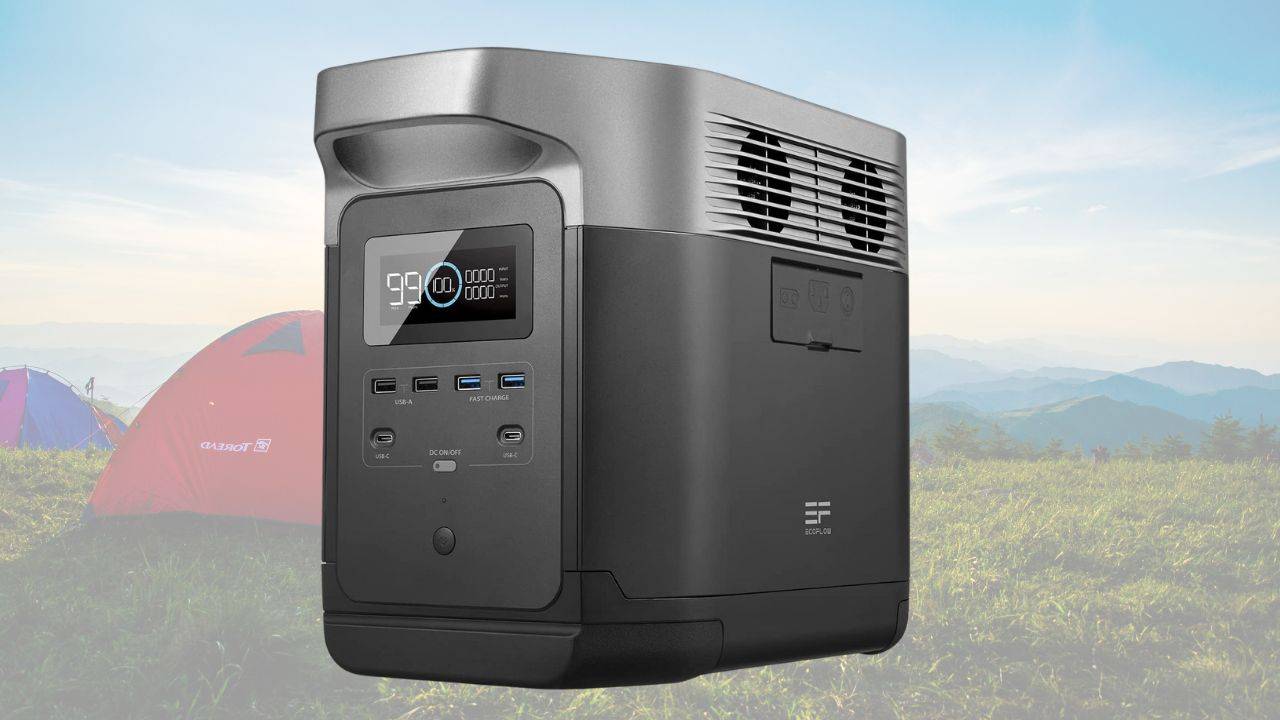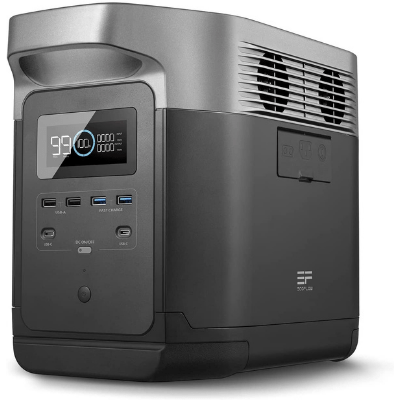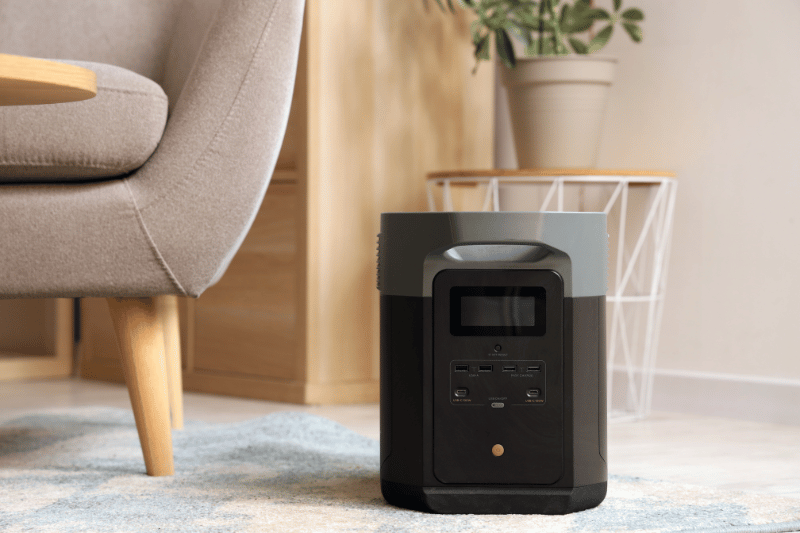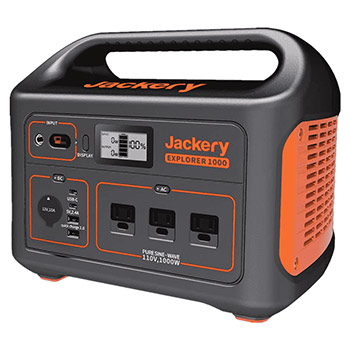EcoFlow Delta 1300 Review: Is It Worth It?
Written by : Nikola Gemeš | Last Updated: March 21, 2024
EcoFlow Delta 1300 Review Summary
In the midst of unpredictable blackouts and evacuations, the EcoFlow Delta 1300 emerges as a potential lifesaver. This portable power station boasts a rapid charging speed and offers an impressive array of output ports to power essential appliances—making it a reliable companion in emergencies.
PROS
Extremely Fast Charging capabilities.
Comes with an array of 13 output ports
Compatible with both AC and solar charging.
Powers various appliances.
CONS
Limited lifespan of 800 charges.
Low round trip efficiency.
The fan is quite noisy.
Despite being advertised as portable, the unit is relatively heavy.
Contents
ToggleThe EcoFlow Delta 1300 is a popular battery generator that can power your appliances and tools. But does it live up to the hype? I tried to find out.

I live in a part of the country that has seen much flooding in recent years. And I can tell you that blackouts, power shortages, and sometimes evacuations, arrive without notice.
As a result, everyone seems to have gotten one of those gasoline generators. Still, I wanted something I could use safely around kids and indoors. So the fuel and toxic fumes had to go.
That’s when I heard about the EcoFlow Delta 1300 — a much-advertised portable battery generator in the market today.
What attracted me instantly was the superior charging speed of 80% in just 1 hour.
But after more than a year of use, can I truly recommend it as a life-saving portable power station?
Let’s see in this first-hand EcoFlow Delta review.
What is the EcoFlow Delta 1300?
The EcoFlow Delta 1300 is a portable power station that can power your appliances and tools in case of an emergency, power outage, or when you’re vacationing off the grid.
The device has standard overload and temperature protection.
The unit casing is made of high-grade aluminum and sturdy plastic, fitted with two carrying handles.
There’s also a big LED display and a total of 13 output ports:
- 4 USB-A ports
- 2 USB-C ports
- 12V car outlet
- 6 pure sine wave AC outlets
How Long Does the EcoFlow Delta Last?
The EcoFlow Delta power station has a lifespan of 800 charges. After that point, the capacity drops under 60%.
In my use, I noticed the capacity dropping after only 500 life cycles.
Well, that’s not a good start.
Sure, you can still use your power station for years, but you’ll have to recharge it more often — and as a result, shorten its life even faster.
What Can the EcoFlow Delta 1300 Power?
The EcoFlow Delta 1300 can power most home appliances including those with sensitive electronics.
For example, you can power lights, hairdryers, microwave ovens, electric kettles, frying pans, fridges, and even a CPAP machine.
With this, I can charge my smartphone more than 180 times and my Macbook about 20 times.
How Fast Can You Charge the EcoFlow Delta Power Station?
You can charge the EcoFlow Delta power station from zero to full charge in only 2 hours, thanks to its new X-Stream Technology.
Using a standard wall outlet, I was amazed to see the charge reaching 80% after only 1 hour.
This is more than 10x faster than most battery generators in its price range, and definitely a new standard for portable station charging.
How Much Does the EcoFlow Delta Generator Cost?
The EcoFlow Delta generator costs $1,399.00. In the box, you get the portable power device, an AC cable for a wall outlet, a car charging cable, a solar panel charging cable, an EcoFlow Delta bag, and a user manual.
What Is the Warranty on the EcoFlow Delta 1300?
The warranty on the EcoFlow Delta 1300 covers 24 months. I haven’t had any issues with mine and didn’t have to contact their customer support, but other users beg to disagree.
What Is the Refund Policy of EcoFlow?
The refund policy of EcoFlow is a bit complicated. If you want a refund within 24 hours of your order, you can request it easily. But between 1-30 days, they’ll likely charge you credit card transaction fees.
EcoFlow Delta 1300 Benefits
Fast Charging
This is definitely the biggest selling point of this power station. Plug the device into a standard AC wall outlet, and the battery goes from zero to 80% in just 1 hour.
This feature helped my family a lot, as we were able to charge the battery in between power outages caused by flooding.
On the other hand, solar panel charging is nothing spectacular. Even in perfect sunlight conditions, it takes between 14-28 hours to fully charge it with two 110W panels.
Number of Ports
You can power up to 13 devices simultaneously and rarely need a power strip.
On a few occasions when I had to evacuate to higher ground, I plugged my phone and camera into the USB ports, which left the AC outlets free for food prep and the refrigerator.
In the end, I never used more than 4 outlets at the same time.
Eco-Friendly
Battery generators are by default far more sustainable than gas generators, as they don't burn fossil fuels and don’t produce fumes. But you can readily use this one with solar panels.
When you pitch the tent or park your RV in the middle of a nature reserve, the last thing you need is a gas generator rumbling around.
EcoFlow Delta 1300 Shortfalls
Short Battery Life
The lifespan of these power stations is not impressive at all. Dazzled by the fact that it charges so fast, I didn’t discover until later that its lifecycle is so short — 800 charges. And this comes straight from the manufacturer.
With my usage, I expect to have this device working for a year and a half more. With plenty of other options around, I don’t think I’ll get another one of these.
Don’t get me wrong, you’ll still be able to power your devices after 800 charging cycles, but your capacity will be cut in half and dropping progressively.
Low Round Trip Efficiency
According to YouTube solar equipment reviewer Will Prowse, this portable power station has a round trip efficiency of only 58%. This means the battery outputs a little more than half the total power that was stored in it. Most portable power systems in this range have an efficiency of 79%.
This is acceptable only if you plan to use it from time to time, but you can forget about using it as your day-to-day off-grid power source.
Noisy Fans
Although advertised as such, this power station is anything but silent.
A loud fan activates every time, whether I charge my phone or plug an electric grill.
To make it worse, the fan runs even when I charge the battery, and even when it reaches full charge (!), no matter the temperature. If you’re looking for a silent operation, you better look for another product.
Otherwise, this device would be perfect for construction sites or in situations where noise is no big deal.
Not So Portable
They call it a portable device, but this generator is definitely not on the light side.
Maybe 30 pounds is not an issue for you, but I have owned and tried many other power stations that were easier to lug around.
This is especially important in an emergency when I try to travel as light as possible.
Also, the two-handle design doesn't work for me at all. There are much better options with one solid carrying handle that leaves the other hand free.
And believe me, when the power goes out in the entire county, you need an extra hand.
Also, the two carrying handles look fancy but are far from ergonomic, especially considering the weight of the entire device.
Pros and Cons Summary of the EcoFlow Delta
Pros
- Charges from 0-100% faster than any competition
- Plenty of different outlets
- Compatible with solar panels
Cons
- Capacity drops under 60% after 800 charging cycles
- Average battery when compared with other power stations
- For occasional use only
- Noisy fans that run all the time
- Limited portability
Things To Consider Before Buying A Portable Solar Generator
What Battery Capacity and Wattage Do You Need?
Battery capacity is usually listed in watt-hours (Wh) while the generator power is given in watts (W). To make it simple:
- Battery capacity = how long you can power your devices when fully charged
- Generator wattage = the maximum power you can plug
For example, the EcoFlow Delta has a 1,260Wh capacity and 1,800W power output. This means a 150W fridge can run for around 8 hours, while you can plug up to 1,800 watts of combined power.
Do You Have the Right Solar Panels?
You can't just assume that the portable power station you buy will work with any solar panels you have at hand. Manufacturers often recommend solar panel options that are compatible with their portable power stations.
If you choose to build your own off-grid kit, pay attention to the maximum solar charging power. For example, the solar input power of 400W means you can use up to three 110W solar panels.
You can risk with the fourth solar panel, but the overload protection will likely kick in and you will lose power.
How Many Devices Do You Expect to Charge at the Same Time?
Most portable power stations have two 110V outlets, a 12V car port, and a couple of USB ports. More is definitely better, but the number of ports alone means little if there is not enough output power to keep all the devices running.
In other words, make sure the number of ports is backed by a large inverter load and surge power.
What Do You Really Need a Generator For?
If you know what you need the portable generator for, you can quickly shorten your list. If you plan to use it in an emergency, you shouldn’t look for anything heavier than 20 pounds.
On the other hand, if you’re building an off-grid solar system to supply your cabin or boat day after day, choose a unit with a large battery capacity. The same applies if you have a CPAP machine that needs to stay powered for 8 hours or longer.
On the other hand, if you need a portable power station for camping, tailgating, or festivals, you don’t need a top performer, but rather something compact that you can haul around.
FAQ
Who is EcoFlow?
EcoFlow is a U.S.-Chinese portable power company that was founded in 2017 by a group of entrepreneurs with a background in the drone industry. The company gained publicity with its Delta and River series of power stations.
What's the best battery generator?
The best battery generator is the Jackery Explorer 1000. It scores points for versatility, quick charging, and portability, making it a well-rounded package that offers more than most users need.
How fast will a generator charge a battery?
A generator will charge a battery very slowly and inefficiently. In some cases, you’ll never be able to get it fully recharged with a standard 12V port generator. Unlike portable power stations, generators are made to power small 12V devices directly, without a battery.
Where is Ecoflow located?
EcoFlow is a multinational company with offices in San Francisco, CA, and Shenzhen, China.
Is EcoFlow a Chinese company?
No, EcoFlow is a U.S.-Chinese company developed by engineers who formerly worked for a Chinese DJI drone company. It is based in San Francisco, CA and Shenzhen, China.
The EcoFlow Delta 1300: Should You Buy It?
In spite of my initial enthusiasm, I can’t recommend the EcoFlow Delta 1300. Yes, it gets charged to 80% in 1 hour, but it falls short in all other areas.
As someone who has used battery-powered generators on and off-grid, I prefer the Jackery Explorer 1000 more. It gives me better battery life, runs quietly, and allows me to carry more stuff along.
It feels at home both during emergencies and on camping trips, where I often use it flawlessly with solar panels.
Thanks to the efficient inverter, the Jackery 1000 gives me better autonomy when fully charged. At one time, it easily kept my gear powered over a 4-day camping trip, with only one solar recharge session.
It’s also a whole 10 lbs lighter than the EcoFlow Delta, and less expensive too.
At the first glance, EcoFlow’s solar generator might seem like a good offer but upon careful consideration, your money is better off invested in the Jackery Explorer 1000.
Nikola Gemeš
Nikola, an electrical engineer, simplifies intricate sustainability subjects for his audience. A staunch environmental conservationist, he embodies his beliefs daily through recycling and cultivating his own food.
| Thank you for Signing Up |


Category: Green Blog, Home Product Review, Most Popular, Product Review, Renewable Energy












A major con that you did not mention is that these Ecoflow solar generators all use low cost (cheap) high frequency transformerless inverter technology that has a low surge capacity compared to high quality low frequency, transformer based inverter tech. The cheap Chinese made high frequency inverters can actually set your appliances on fire during a catastrophic H-Bridge failure.
Hi,
I’m following this with interest. We in South Africa have a unique situation of blackouts a few hours every day, 365 days a year due to problems with the National electrical grid. We call this ‘load shedding’ (Google it, as I’m not going to go into the madness of why it is happening).
So, we find ourselves in a unique situation to test these products, as we literally need fast-charging, battery-powered generators every day. We live in a flat, and cannot afford to install an inverter at present – ridiculously expensive at the moment. @George, proving the point that people do find themselves in situations when they need to use Ecoflows or other ‘portable power stations’ 365 days a year.
I really appreciate this review, as I bought my Ecoflow River Pro 720 on the 1st of February, and it has depreciated in power with frequent use (it’s now 28 April). It’s only been three months, and I’ve lost an hour’s worth of power. Load shedding is done in stages, so Stage 1 is electricity off for 2 hrs of the day. Stage 6, however, is a nightmare, with electricity going off for 4 hrs at a time, sometimes 2 times a day (see stages here, each number corresponds with an area and how often it gets switched off in Cape Town: https://www.capetown.gov.za/Loadshedding1/loadshedding/maps/Load_Shedding_All_Areas_Schedule_and_Map.pdf).
So, I really needed my River Pro to do what it says on the box. I needed a system that would power a few items during those four hour stretches, and that I could then quickly recharge in the 2hrs before the next ‘load shedding’ cycle. At 100W/h, I thought my River Pro would easily cover the 4 hrs, and initially it did, with about +20% of battery life left. Three months later, and it can only power my devices for 3 hrs, with 20% battery life left.
If the product should not be frequently used, the company really should say so! I really didn’t get that impression. I would have bought something else, even if it takes longer to charge. It has only ever been fully discharged once, and the rest of the time I take care to ensure it doesn’t drop below 20%. Then recharge and put aside, without leaving it plugged in. I have been keeping a detailed record of everyday use and the drop in performance, and it’s worse than you think Nikola. An acquaintance of mine has stopped using his altogether, with only an hour’s worth of power left after less than a full year’s use.
So thank you for this review, as I bought mine on Takealot.com, and everywhere everyone is raving about it, but only after reviewing it after a few days or a month. Please advise further on what one can use every day – I’m not even that convinced about Jackery being able to cope with our ‘load shedding’, and cannot test every single product to find the right one. Besides, it can’t be good for the environment for people to have to keep discarding portable generators that don’t last. Please advise on whether the Bluetti LifePO4 1000W would be able to cope with 4hrs of use, recharge and re-use every day (Jackery 1000 is not available to us at the moment, Bluetti boasts 2500+ cycles).
I have 5 ecoflow units and have had to replace 3 due to malfunctioning, so the concept is better than the current reality. However, problems are to be expected, and the real major problem is customer service. Its extremely erractic, going from great one day to horrible the next. Theres no consistency. EX. One of my units just broke down, I went thru the troubleshooting via phone with ecoflow customer service, ending in telling me it had to be replaced under the warranty. After supply all the requested information, I received an email stating how happy they are my problem is solved, goodbye. This is downright insulting, truly. I would elaborate on my other problems but they are too hideous to relive. Lets just say I had to get the authorities involved. So, my best advise is to research the market very well, keying in on quality, dependability, and certainly customer service. Any company getting bad reviews on customer service, I would completely avoid doing business with because sooner or later you will need it.
Pingback: 8 Great Benefits of Solar Panels for Your House
John UK
Did some measurements on my Delta Max 2016Wh unit and one thing to be aware of. If you leave it unloaded with the AC output still switched on (nothing plugged in to it, no load). It “leaks” around 50W/hr. Assuming this “leakage” (Actually it’s the batteries powering the internal electronics in the unit) is constant with load, (and maybe the manufacturer may wish to comment on this) as a percentage of 2016kW (full load) that’s just 2.5% of your power lost. Great you say! BUT Lets say you (like me) tried to use it to power a file server 24/7 taking just 70Wh that’s a massive 70% of your stored power gone.
The upshot of this is that this unit is perfectly efficient for running large power loads for a relatively short time but not for running a small load for a long time.
I just bought the Ecoflow Delta 1300 for $949 from Costco. It seemed comparable for similar powerful units. I really only bought for the occasional power outage and camping trip. I haven’t seen anything about replacing batteries on this unit. Are they replaceable?
For those of us with the SMA Secure Power Supply on our inverter(s), the speed of charging is enough to justify the purchase of one or more Ecoflow Delta 1300s as emergency backup for grid-down situations. Since the Secure Power Supply is only operable while the sun is shining, we can use one SPS to power our critical appliances and the other to charge the Ecoflow(s) for night time use.
Pingback: How To Save Electricity Costs By Using A Generator – Esto Solo Lo Arreglamos In Las Autonomias
The first time I plugged in my ecoflow Delta to charge it – it took the power out of my condo and I had to hire an electrician. I have tried to contact the company but no one responds to my emails and their customer service phone is only to the Phillipines. They said they have no American customer service people. Can you please tell me who to call. I can’t afford to have my power go out and hire an electrician just to charge it.
We’re very sorry to hear it. Please call this number (+1 (800)-368-8604 Mon-Fri 9 am-9 pm (EST)), this EcoFlow’s official customer support line for North America.
Also, you should check out their contact page (https://ecoflow.com/pages/contactus)
Interesting review. Just have a question. You have had this for a year. 365 days. But you have gone through 500 full discharge /recharge cycles? So on 165 days, you have had to discharge and recharge twice? Where do you live or do where you would need o do this on a daily basis? With your environmental background, do you not at least have solar? At least a portable solar panel for the Delta?
With 100 watts of solar coming in to offset the energy going out, your Delta should give some more runtime. Besides, with solar recharging, it is easier on the battery and will increase the longevity as opposed to using the extreme fast charging<2hr wall AC method.
Tesla owners who charge at home vs using a Supercharger station report less capacity loss over the years due to the less brutal fast charging method. Of course the Delta doesn't provide a lower charge rate from wall AC. My 720 River Pro does.
If your power is out, how do you recharge the Delta? Drive accross town to a area that has power, plug it it then drive back to your dark home to plug in you stuff? Even if you have a few weather related blackouts and need the Delta for a backup, most people will only need it to charge cell phones, laptops, tablets and power the internet mode/router, power a few 10 watt LED bulb lamps for lighting.
That is all I want my River Pro to do. Hardly enough to make a dent in the capacity. I am have a hard time trying to see just what you need to power that will consume the entire capacity of the Delta on a daily basis. Are you trying run a refrigerator or freezer every day for a few hours? Why would you try to use the Delta for that? You need a 2-3-5kw gas generator, not a small capacity backup battery bank. It would seem illogical to think that a 1200 wh battery bank is going run your fridge for several days.
Lets compare something that uses Li-on batteries as well. How long do you keep your cell phone before you see battery capacity run down. 2 years maybe.
So discharge and recharge once a day for two years, which would be normal equals 730 cycles and of course it was probably not lasting as long as it used to before that two year mark, which is when the new model gets released of course. And if it's an iPhone, what is the price of an iPhone 12? Wow! nearly a thousand dollars. The Delta maybe a couple of hundred dollars more. And the iPhone will last about two years because of the weakening battery, old software etc.
A cell phone will get daily charges 95-100% of the time you own it. The Delta will sit unused 90-95% of the time for the majority of folks who will buy it. I have had the River Pro for 4 months now and haven't used it once for power outages since the ones I have had only last a few minutes. The longest I have had recently was for several hours. The longest was for three days during winter years ago. So I anticipate the River could last me decades at this rate of use. Just in case you think I don't have a big enough backup, I have a dual fuel 3500kW Champion Inverter Generator which can charge up the River so I can take it back inside to power/recharge the small stuff, keeping that load off of the Champion which is powering the critical/large appliances. I understand what the EcoFlow can and can't do.
Jackery explorer 1000 claims *500* cycles before a 20% loss. Let's make it clear what a cycle means. A cycle is a 100% discharge to zero and then recharge to 100%. If you are down to 50% charge and recharge to 100%, that is a half cycle. So if you only ever discharge to 50% and recharge to 100% that mean you get 1000 half cycles and after that at 80% capacity.
You say that you were able to use solar panels to recharge on a 4 day camping trip. I will assume you used the Jackery 100watt panels which can probably only output about 70 watts. And when camping you will be limited by the sunlight hours and most likely trees and foliage blocking the sunlight so maybe 5 hours of sunlight which is not enough to fully charge a Jackery to 100%. It takes 8 hours or more for solar. Maybe all you needed was a 20% charge. Just a couple of 10000 mah battery banks in the car or back pack is simpler to recharge cell phones instead of the Jackery or Delta. If you really have experienced 500 full cycles in a year, I have to take your word for it. It just doesn't sound feasible to me.
George you make some very good points there. This seems like a particularly harsh review of the eco flow delta and it makes me question the points made.
Sending this from the UK. I too am also curious about the number of cycles stated here.
Our extensive field research with working teams at roadside in the UK shows that a full cycle (defined as 100% to zero, then back to 100%) almost never happens on a daily basis even in hard working environments. A full cycle is usually seen every two working days or even three.
A battery with 800 cycles will therefore produce between 1600 and 2400 decent working days from a unit. If you work five days a week with these you will be getting between 3 and almost five years’ work from it as a portable power station.
The current pace of change of battery technology will see substantial changes to the interface on these products, rendering any current model quite dated fairly quickly. Don’t go for a 2000 cycle unit whatever you do unless it’s a stable long term environment (non portable) you are catering for. Let’s not confuse portable features and non-portable.
Another point – labelling them as Battery Generators is misleading. A generator converts mechanical energy into Electricity. This is a power delivery system. Generators require a specific approach that is very different – particularly in safety regulations such as grounding.
In the UK the Delta is the favoured work-horse for both business and leisure, with the Delta Max now arriving and creating very significant interest with businesses. hope this helps.
Hello Merv,
As I responded to George, not all my cycles were organic. For a large part, I used an automated battery simulator. I’m aware that in real-life use one would not always discharge the battery completely. The problem is that manufacturers advertise and boast about those lifecycles so we give each of the products a thorough shakedown. After all, there are many other perks that each of these solar generators has to offer.
As for labeling, I see that you have a technical mind like myself. Those are indeed not generators but power units that consist of a battery, inverter, and a switchboard to make it all work. The problem is that the customers and even retailers keep calling them Battery generators. So when people are trying to find something more about them, that’s what they google most of the time.
I didn’t know that the Delta is so popular in the UK. Thanks for your very helpful and insightful comment.
Hi George, Thank you for making such an elaborate and knowledgeable comment. I’m glad that you’re happy with your 720 River Pro. We’re not trying to step on anyone’s toes here, just give fair reviews and recommendations to our readers. I’m going to answer the points you made:
“But you have gone through 500 full discharge /recharge cycles? So on 165 days, you have had to discharge and recharge twice? Where do you live or do where you would need o do this on a daily basis?”
Not all my charge/discharge cycles were organic. It would take indeed a lot of time, so for the most part I used an automated battery simulator. That’s how I managed to reach 500 life cycles in less than 365 days.
“With your environmental background, do you not at least have solar? At least a portable solar panel for the Delta?”
Yes, I have solar panels. The Delta can take charge from either solar panels or the utility grid.
“Besides, with solar recharging, it is easier on the battery and will increase the longevity as opposed to using the extreme fast charging<2hr wall AC method."
The device is designed and advertised for dual charging, and this is what customers expect. I agree that it's easier on the battery if one uses only solar charging.
"Tesla owners who charge at home vs using a Supercharger station report less capacity loss over the years due to the less brutal fast charging method. Of course the Delta doesn't provide a lower charge rate from wall AC. My 720 River Pro does."
All these solar generators have different perks. This is the EcoFlow Delta with all of its pros and cons we're talking about.
"If your power is out, how do you recharge the Delta? Drive accross town to a area that has power, plug it it then drive back to your dark home to plug in you stuff?"
I don't. This is an example of use. The Delta's super fast AC charging comes in handy in those situations when you don't know when the next blackout will strike, so you better top off your battery.
"That is all I want my River Pro to do. Hardly enough to make a dent in the capacity. I am have a hard time trying to see just what you need to power that will consume the entire capacity of the Delta on a daily basis. Are you trying run a refrigerator or freezer every day for a few hours? Why would you try to use the Delta for that? You need a 2-3-5kw gas generator, not a small capacity backup battery bank. It would seem illogical to think that a 1200 wh battery bank is going run your fridge for several days."
The Delta can power a mobile or stationary fridge in a pinch without difficulties for a short time. This solar generator is not meant for day-to-day use even with solar panels. It simply lacks power and capacity. Still, we have to make this clear to our readers. Call it myth-busting if you like.
"Lets compare something that uses Li-on batteries as well. How long do you keep your cell phone before you see battery capacity run down. 2 years maybe. So discharge and recharge once a day for two years, which would be normal equals 730 cycles and of course it was probably not lasting as long as it used to before that two year mark, which is when the new model gets released of course. And if it's an iPhone, what is the price of an iPhone 12? Wow! nearly a thousand dollars. The Delta maybe a couple of hundred dollars more. And the iPhone will last about two years because of the weakening battery, old software etc."
Battery degradation is an inevitable process. Yet, I can hardly compare a solar generator and an iPhone. This is a product people want to buy and use hard without thinking about the next model and the fancy new set of perks and upgrades.
"A cell phone will get daily charges 95-100% of the time you own it. The Delta will sit unused 90-95% of the time for the majority of folks who will buy it. I have had the River Pro for 4 months now and haven't used it once for power outages since the ones I have had only last a few minutes. The longest I have had recently was for several hours. The longest was for three days during winter years ago. So I anticipate the River could last me decades at this rate of use. Just in case you think I don't have a big enough backup, I have a dual fuel 3500kW Champion Inverter Generator which can charge up the River so I can take it back inside to power/recharge the small stuff, keeping that load off of the Champion which is powering the critical/large appliances. I understand what the EcoFlow can and can't do."
That is why we don't only test and review individual products but also offer Top 10-style reviews of the best products at a given time. We want our readers to see for themselves what each generator can and can't do, so they can choose the one that suits their needs.
Every battery is prone to self-discharge and degradation over time, even when you're not using it.
The problem with these gas generators is that they use a lot of fuel even on standby and with small electric loads (vs. needed electric power). These solar generators, on the other hand, are much more efficient in this sense – they have much fewer losses on small loads.
"Jackery explorer 1000 claims *500* cycles before a 20% loss. Let's make it clear what a cycle means. A cycle is a 100% discharge to zero and then recharge to 100%. If you are down to 50% charge and recharge to 100%, that is a half cycle. So if you only ever discharge to 50% and recharge to 100% that mean you get 1000 half cycles and after that at 80% capacity."
In our testing, we always discharged the battery to zero.
"You say that you were able to use solar panels to recharge on a 4 day camping trip. I will assume you used the Jackery 100watt panels which can probably only output about 70 watts. And when camping you will be limited by the sunlight hours and most likely trees and foliage blocking the sunlight so maybe 5 hours of sunlight which is not enough to fully charge a Jackery to 100%. It takes 8 hours or more for solar. Maybe all you needed was a 20% charge. Just a couple of 10000 mah battery banks in the car or back pack is simpler to recharge cell phones instead of the Jackery or Delta"
In my reviews, I often introduce situations that our readers can identify with. Not all campsites are in the thick of the forest. I like to camp light, so I didn't bring more thirsty appliances that could benchmark the intensive use in the outdoors. As you say, perhaps someone else would use the car battery or power banks. In different situations, we'd all do something differently.
GreenCitizen is an environmental conservation company providing you with information, services, and products to help you live a sustainable life.
Follow Us
Join Our Newsletter
Quick Links
Blogs
Services(United States)
For Businesses
For Homes
Useful Links
Copyright © 2024 · All Rights Reserved · GreenCitizen
Privacy Policy | Affiliate Disclosure